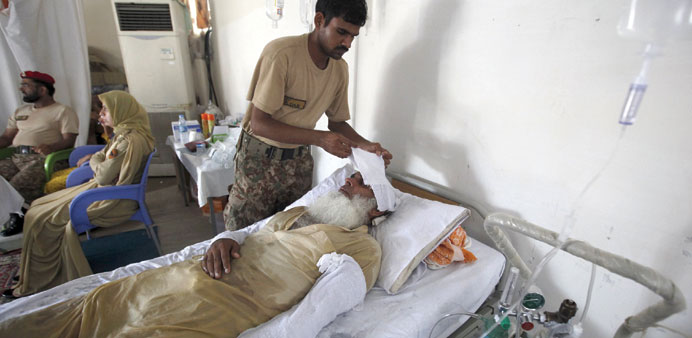Agencies/Islamabad
The devastating heat wave that struck Pakistan’s Sindh province is slowly subsiding but the toll has climbed to 1,242 with 32 deaths reported in Karachi yesterday.
Various government-run hospitals in Karachi confirmed that at least 32 people died of heatstroke yesterday, reports Dawn.
At least 13 people died in Jinnah Postgraduate Medical Centre (JPMC), 11 in A bbasi Shaheed Hospital (ASH), two in Qatar Hospital, three in hospitals owned by Karachi Municipal Corporation (KMC) and three in other hospitals in the city.
The crisis in Karachi was worsened by poor service delivery, including a faulty power grid and shortage of potable water.
After peaking at around 45 degrees celsius last weekend, the heat wave has subsided and the city’s customary cooling sea breeze has begun to blow, bringing relief to its 20 million inhabitants.
The city’s morgues struggled to cope with the influx of the dead, many of whom were elderly, destitute or drug addicts.
Meanwhile, environmentalists and forest experts suggested Karachi needs immediate plantation of indigenous trees, artificial forests near the city and more public parks with big trees.
“Ideally, there should be one tree for one person,” said Niaz Soomro, the director-general of parks and horticulture, Karachi Metropolitan Corporation (KMC). “We (Karachiites) are at least 65% behind target.” Soomro’s department maintains around 140,000 trees of the Conocarpus specie that were planted on the city’s main roads, Sharae Faisal, Karsaz Road, Rashid Minhas Road, New MA Jinnah Road and University Road, in 2008 as part of the ‘Green Karachi’ project.
“There is no space for trees in the city,” said Soomro. “Water shortage is another issue.” He suggested setting up artificial forests near the city. “They could be on the National or Super highways,” he said.
Environment experts believe that monoculture is anti-environment. According to them, exotic trees contribute to environmental pollution. “Multicultural plantation is required,” suggested Javed Ahmed Mahar, a forest expert and the conservator of Sindh Wildlife Department.
According to him, the city had its own indigenous trees, including Banyan, Ficus, Gulmohar, Kamini, Neem and Tamarindus.
“One feels different when passing by old trees in the city,” he said, adding that the plantation of more local trees will certainly bring a rapid environmental change in Karachi. Mahar felt that the disappearance of forest trees from both sides of the Indus river contributed to the weather change.
Nadeem Mirbahar, an environment expert associated with the International Union for Conservation of Nature, disclosed that there was only 7% vegetation cover in the city in 2008.
He said that the survey covered the entire geographical boundary of Karachi. “The minimum requirement is at least 25%,” he said, adding that according to a plan initiated in 2008, the government had to launch a project to increase at least 7% more cover in 10 years. “I don’t think it has been implemented as yet.”
Talking about the current heatwave in Karachi, Mirbahar said that it is not limited to roads or open spaces alone any more. “The heatwave directly hits your home, office and shops,” he explained.
“We need environment-friendly construction.” He further suggested that everyone should own at least one tree. “The trees regulate environment and reduce the urban heat island effect.” Most experts believe that ruthless cutting of trees and residential schemes in the port city have also contributed to the unbearable weather.
“Trees are our asset,” said a senior official of the KMC, Raza Abbasi. “It is a crime to cut a tree.” He said that it takes years for a tree to bloom but people chop it down in minutes. “Unfortunately, we don’t have forests and need green areas urgently.”
The Sindh forest department refuses to share responsibility in the city’s forest cover. “We maintain coastal forests,” said Sindh forest department chief conservator Mir Nadir Ali Talpur, adding that it is the responsibility of the city government to maintain vegetation cover in Karachi.
Talpur said that mangroves are spread over an area of 175,000 hectares across the coastal belt of Sindh, with the majority of the area in Karachi and Thatta.
Many experts said that there is a lack of planning in the public sector department. They said that the concept of plantation and the importance of greenery do not exist among the citizens.
“The Bin Qasim Park is the biggest park of the city but do you see any big tree there?” asked Mirbahar.
“The people of Karachi need large trees. We have to bring our trees back and it’s high time to realise its importance or we’ll have a tough time in the coming years.”

A man, who collapsed due to an intense heatwave, has water-soaked towels placed on his head and arms at an Army camp, set up outside an emergency depa


